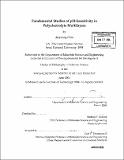| dc.contributor.advisor | Michael. F. Rubner. | en_US |
| dc.contributor.author | Choi, Jeeyoung, 1974- | en_US |
| dc.contributor.other | Massachusetts Institute of Technology. Dept. of Materials Science and Engineering. | en_US |
| dc.date.accessioned | 2006-03-29T18:28:51Z | |
| dc.date.available | 2006-03-29T18:28:51Z | |
| dc.date.copyright | 2004 | en_US |
| dc.date.issued | 2004 | en_US |
| dc.identifier.uri | http://hdl.handle.net/1721.1/32263 | |
| dc.description | Thesis (Ph. D.)--Massachusetts Institute of Technology, Dept. of Materials Science and Engineering, 2004. | en_US |
| dc.description | Includes bibliographical references (leaves 126-136). | en_US |
| dc.description.abstract | This thesis investigated the fundamental characteristics of the pH-sensitive behavior of weak polyelectrolytes, such as poly(acrylic acid)(PAA) and poly(allylamine hydrochloride) (PAH) from two perspectives of the assembled multilayers - functional group composition and layer growth. In the first part of this thesis, with respect to the composition control of the functional groups, the assembly conditions to create surfaces that were dominated by specific functional groups were investigated, either to promote or inhibit adsorption of other entities onto the multilayer surfaces. After selective irreversible anchoring, the multilayer surface then acquires the specific physical or chemical properties of the newly incorporated molecules. For example, polystyrene-block-poly(acrylic acid)(PS-PAA) selectively adsorbs to the PAH-rich surfaces of PAA/PAH multilayer films thus rendering the originally hydrophilic PAH-rich regions hydrophobic. Furthermore, by using micro-patterned multilayers via ink-jet printing, two co-existing surface regions that selectively dictate the adsorption behavior of amphiphilic block copolymers were successfully generated. In the second part, the effects of the charge density of weak polyelectrolytes on multilayer growth were quantified by assembling PAA or PAH with several strong polyelectrolytes into multilayers and comparing the results with that of PAA/PAH multilayers. | en_US |
| dc.description.abstract | (cont.) Specifically, by using a transmission FT-IR analysis on dried films, the threshold of the charge density where the resulting layer thickness exhibits a sudden incremental change due to a different chain conformation and amount of the adsorbed molecules in the multilayers was identified. Also, the pKa of PAA was revealed to shift by choice of co-assembled polycations within the multilayers, which was expanded to investigation of applications in in-situ synthesis of silver nanoparticles and pH-induced morphological transformation in weak polyelectrolyte multilayers. | en_US |
| dc.description.statementofresponsibility | by Jeeyoung Choi. | en_US |
| dc.format.extent | 136 leaves | en_US |
| dc.format.extent | 5694002 bytes | |
| dc.format.extent | 5691600 bytes | |
| dc.format.mimetype | application/pdf | |
| dc.format.mimetype | application/pdf | |
| dc.language.iso | eng | en_US |
| dc.publisher | Massachusetts Institute of Technology | en_US |
| dc.rights | M.I.T. theses are protected by copyright. They may be viewed from this source for any purpose, but reproduction or distribution in any format is prohibited without written permission. See provided URL for inquiries about permission. | en_US |
| dc.rights.uri | http://dspace.mit.edu/handle/1721.1/7582 | |
| dc.subject | Materials Science and Engineering. | en_US |
| dc.title | Fundamental studies of pH-sensitivity in polyelectrolyte multilayers | en_US |
| dc.type | Thesis | en_US |
| dc.description.degree | Ph.D. | en_US |
| dc.contributor.department | Massachusetts Institute of Technology. Department of Materials Science and Engineering | |
| dc.identifier.oclc | 56025642 | en_US |
